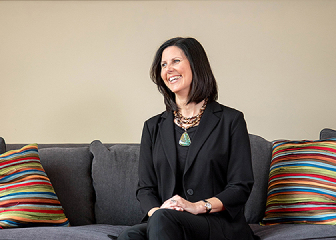Donor-advised funds: Flexible, tax-friendly, and just the beginning
As attorneys, CPAs, and financial advisors, you’ve no doubt noticed that financial publications’ coverage of donor-advised funds is increasing. This is no surprise, considering that these popular vehicles can help your clients achieve both their financial and philanthropic goals.
What many advisors don’t realize is that a donor-advised fund at the Foundation is not only useful as a standalone tool, but even more importantly, it can serve as the flexible foundation of a client’s overall charitable giving portfolio. Here’s how this works:
Organize annual giving
Fundamentally, a donor-advised fund offers a centralized way for a client to manage gifts of cash, appreciated stock, and other assets while maintaining flexibility in timing grant distributions to favorite charities. This flexibility is especially important for some clients as a planning tool in 2025 before the new floor and cap kick in next year on itemized charitable deductions. “Bunching”—or front-loading—multiple years of charitable contributions into a donor-advised fund this year can create meaningful tax advantages and provide a ready reserve of philanthropic capital for years to come.
Wide range of tools and resources
The donor-advised fund itself is just the beginning! Beyond enjoying convenience and tax efficiency, your clients who establish donor-advised funds with us can work closely with our knowledgeable team to access even more charitable giving resources and vehicles that align with your clients’ charitable goals.
Community impact
Our deep understanding of local nonprofits and community priorities can help clients enhance their engagement and impact. Our team provides insights, research, and connections that help your clients understand where their dollars make the most difference—turning charitable intent into meaningful outcomes.
A variety of fund types
The CFGC offers a wide range of options beyond just donor-advised funds. A designated fund, for example, enables your client to provide long-term support to specific organizations. A field-of-interest fund targets specific causes your client cares about that are being addressed in the community by several nonprofits and sometimes even by the Community Foundation itself.
Giving from IRAs
A client who is 70½ or older can transfer Qualified Charitable Distributions (QCDs), up to $108,000 per taxpayer (2025 IRS limit), from IRAs to a designated, field-of-interest, or unrestricted fund at CFGC, such as the Fund for Chattanooga, and in the process, bypass taxable income.
Legacy strategies
Our team is happy to help you integrate legacy planning strategies into clients’ charitable giving portfolios. Whether through bequests in wills and trusts, or through beneficiary designations on life insurance or retirement accounts, naming a donor-advised or other fund at the Community Foundation allows your clients’ charitable intentions to extend across future generations. We offer ongoing support and stewardship, ensuring clients’ charitable intent is preserved and aligned with evolving community needs over time.
What’s the bottom line here? Partnering with us helps your client’s donor-advised fund function not only as a tax-efficient giving vehicle, but also as the dynamic, flexible foundation of a comprehensive charitable portfolio—built to adapt through changing tax environments and community priorities.
Bread and butter strategy: QCDs for clients 70½ and older
As the economic and legislative environment continues to evolve, advisors are sharpening every tool they have to help clients meet both their financial and charitable goals. Provisions enacted as part of the One Big Beautiful Bill Act (OBBBA) are prompting renewed focus on strategies that merge tax efficiency with meaningful community impact. Among the most powerful tools in this space for clients age 70½ and older is the Qualified Charitable Distribution, or QCD.
IRA assets in the United States total nearly $18 trillion, and the vast majority of your clients likely own at least one IRA. You’re likely very aware that traditional IRAs are among the most heavily taxed assets for retirees because withdrawals are generally treated as ordinary income, often pushing retirees into higher tax brackets when they begin taking required minimum distributions at age 73. In addition, IRAs are fully includable in the owner’s taxable estate, meaning heirs may face both estate taxes and income taxes when they inherit the account. This double layer of taxation can significantly erode the value of an IRA, making it one of the least tax-efficient assets to pass to beneficiaries compared to other holdings.
Against this backdrop, the QCD can come in very handy. A QCD allows an individual aged 70½ and older to give up to $108,000 in 2025 directly from an IRA to an eligible charity. As a result, the QCD is a tax-savvy way for clients to fulfill charitable intentions while managing taxable income.
Here’s why QCDs are more important now than ever:
– Although the OBBBA doesn’t directly change QCD rules, it’s likely to make them even more relevant. The reason is that QCDs reduce adjusted gross income (AGI) rather than operating as an itemized deduction. That distinction is crucial because the OBBBA will continue to influence how many taxpayers itemize, particularly older adults.
– Because a QCD can count toward required minimum distributions (RMDs) without increasing taxable income, it provides a double benefit: supporting charitable organizations while helping to manage income-related Medicare surcharges (IRMAA) and preserving tax credits and deductions that phase out as AGI rises.
– Starting in 2026, under the OBBBA, the Internal Revenue Code will impose a 0.5 percent of AGI floor for deducting charitable contributions, and also limit the value of those deductions for high-income taxpayers by capping the benefit at 35 percent, even when the taxpayer’s top marginal rate is 37 percent. The practical impact is that your high-income-earning clients will experience reduced tax advantages from traditional itemized charitable deductions in the years ahead.
We can help you structure a QCD that supports the causes your clients care about—whether through a field-of-interest, designated, or unrestricted fund. While donor-advised funds can’t receive QCDs, many families work with the Foundation to maintain multiple types of funds side by side, often pairing the flexibility of a donor-advised fund with a fund that can receive QCDs.
Now is the time to revisit these strategies with your clients. Together, we can help them give meaningfully, reduce tax exposure, and continue to make an impact in the community we all love.
Rare but powerful “charitable exits”: Know it when you see it
If your client base includes business owners, you’re no doubt at least generally aware of the benefits of giving closely-held business interests to charity. Beyond that, though, the details may get fuzzy. That is totally understandable! Most advisors encounter only a few of these opportunities over an entire career. The key is to be able to recognize the opportunity so you can reach out to the Community Foundation team to help you make the most of it for your client.
Let’s take a look at how this plays out for a hypothetical client, Alex Monroe, who may have a few things in common with your actual business owner clients.
– When Alex began considering selling his company, he mentioned it only casually to you. But you knew enough to listen carefully because you know Alex has given generous gifts to several favorite charities over the years. You re-familiarized yourself your Community Foundation in anticipation of the ongoing conversation with Alex.
– You also know that the value of Alex’s company has grown substantially over the years, accumulating significant unrealized capital gains for Alex. If Alex sold now without additional planning, a large portion of the proceeds would go toward capital gains tax, potentially eroding the value he had worked so hard to build.
– Some business owners in Alex’s position would rush into the exit process with their advisors by putting feelers out to potential buyers, determining an asking price, jumping to establish a letter of intent with a leading suitor, and in the process, missing strategies that could improve their post-sale outcome.
– In Alex’s case, though, you suggest involving CFGC early in the process. You shared with Alex that it’s worth considering giving a portion of the company’s shares to a donor-advised fund with us before any formal sale activities begin.
– You explain to Alex that by making this charitable gift well in advance of the eventual sale, the shares owned by the donor-advised fund will not trigger capital gains for Alex. Instead, the donor-advised fund will receive the proceeds free of capital gains tax and ready to deploy toward Alex’s philanthropic goals. What’s more, this technique delivers an estate tax advantage by removing the gifted portion of the business from Alex’s taxable estate.
Whether you encounter a situation like Alex’s once, twice, or dozens of times during your career, the most important tip to remember is to reach out to the Community Foundation team during the very early stages of planning a client’s business exit.
Transactions like this take time and also require navigating a few pitfalls. For example:
– Obtaining a qualified appraisal is crucial to comply with IRS rules for charitable deductions for gifts of non-cash assets. Failure to strictly comply with IRS rules could wipe out the tax deduction.
– For this type of transaction to avoid capital gains tax, it is important that no formal discussions about the sale, no shareholder vote approving a transaction, and no signed letter of intent are in place before the gift of shares. Otherwise, the IRS may disallow the charitable deduction.
– These transactions are typically much more effective when the stock is given to a public charity, such as the Community Foundation, rather than a private foundation. Unfortunately, some tax advisors are not aware of the significant differences in the tax benefits of giving closely-held business shares depending on the IRS status of the receiving entity. And of course, we have a process to review each potential gift carefully to ensure compliance and feasibility.
One of these days, whether it’s next week or six years from now, you’ll likely encounter a charitably-minded business owner who decides it is time to explore selling the business. In that situation–and in any other situation involving charitable giving–the Community Foundation is honored to be your first call.
The team at the Community Foundation is honored to serve as a resource and sounding board as you build your charitable plans and pursue your philanthropic objectives for making a difference in the community. This newsletter is provided for informational purposes only. It is not intended as legal, accounting, or financial planning advice. Please consult your tax or legal advisor to learn how this information might apply to your own situation.








